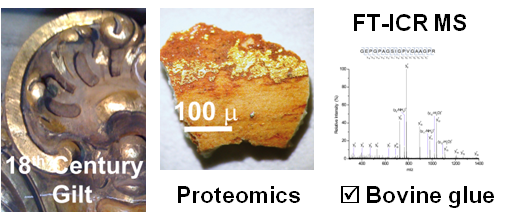Accueil du site > Production scientifique > Identification of Animal Glue Species in Artworks Using Proteomics : Application to a 18th Century Gilt Sample
Identification of Animal Glue Species in Artworks Using Proteomics : Application to a 18th Century Gilt Sample
Date de publication: 20 octobre 2011
S. Dallongeville, M. Koperska, N. Garnier, G. Reille - Taillefert, C. Rolando, C. Tokarski
Anal. Chem. (2011). DOI
Travail réalisé sur le site de l’Université de Lille 1, Sciences et Technologies.
Abstract

This study proposes a proteomic-based strategy for the identification of the origin species of glues used as binding media in artworks. The methodology, based on FT-ICR high resolution mass spectrometry, was evaluated on glues from different animal origin (i.e. bovine, rabbit and fish). The analysis of the peptide mixture resulting from the enzymatic hydrolysis of the proteins led to the identification of species-specific peptides. Up to 15 specific peptides were identified for the bovine species, 3 for the rabbit species and, in the case of sturgeon glue, 3 fish-specific peptides were found by sequence homology to the rainbow trout. Then, the method was applied to authenticate different rabbit skin glue samples, including a 100 year-old sample named ‘Colle à Doreurs’ coming from the ‘Maison Totin-Frères’. For this sample, two specific peptides of rabbit collagen were identified. To evaluate the method on complex matrix, model paintings composed of lead white, linseed oil and animal glue were prepared. Species-specific peptides were identified in each painting sample. Finally, a gilt sample from St Maximin church dating from the eighteenth century was analyzed and we managed to identify 13 peptides specific to bovine collagens starting from approximately 50 μg of sample.








